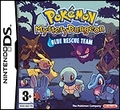You can trust VideoGamer. Our team of gaming experts spend hours testing and reviewing the latest games, to ensure you're reading the most comprehensive guide possible. Rest assured, all imagery and advice is unique and original. Check out how we test and review games here
Pokémon Mystery Dungeon is not, strictly speaking, a Pokémon game. It is a Mystery Dungeon game. Chunsoft has been developing these simple little dungeon crawlers for years now. Usually they use either Chunsoft’s own, Dragon Quest or even Final Fantasy characters, and consequently their appeal is limited outside of Japan: Pokémon Mystery Dungeon is the only one other than the PlayStation’s Chocobo’s Mysterious Dungeon and its sequel to be released elsewhere. These, then, are absolutely nothing like the usual Pokémon handheld games. Just so you know.
Consequently it would be rather unfair to directly compare Mystery Dungeon to the likes of Diamond and Pearl, as it would inevitably come out worse. It’s what is known as a ‘roguelike’ – that is, it uses many of the elements first popularised in the famous 1980’s ASCII-graphic dungeon crawler, Rogue. Such games are unique in their randomly-generated dungeons and characteristic turn-based movement. When you take a step, every other enemy in the dungeon also takes a step; so whilst Mystery Dungeon might seem to operate in real-time, it is actually a turn-based adventure at heart. Of course, Pokémon Mystery Dungeon differs from traditional roguelikes in that it puts pretty graphics in place of the traditional symbols and letters and actually uses sound, but in all other respects it is a very old-fashioned soul.
Both versions of Pokémon Mystery Dungeon are exactly the same (Blue on DS, Red on GBA), save for Blue’s extra screen (which is put to fabulously innovative use as a map display) and the customary few differences in the selection of Pokémon. They begin by ascertaining, via a non-threatening little personality quiz, which of sixteen Pokémon you get to turn into for the duration of the game. Waking up as a Pokémon in a world without humans, the player discovers that a series of strange natural disasters are causing considerable bother in this parallel universe, and with the help of your chosen rescue team partner (don’t choose Charmander, he’s a complete wimp), you’ll delve into random item-peppered dungeon after random item-peppered dungeon in pursuit of Pokémon in need of aid. The actual story involves getting to the source of these natural disasters and, in the process, finding out exactly why you became a Pokémon in the first place. And a charming tale it is too – it incorporates all of the warm and fuzzy themes of friendship, hard work and perseverance that we’re used to from Pokémon in all its various iterations.
Beyond completion of the main story arc, the game stretches out almost to infinity. You can continue to accept jobs from Pokémon in need of aid, which are posted on the adorable little Pokémon town’s notice board, until you reach the top Rescue Team ranking (which would take at least forty hours), you can continue to follow other little story arcs that appear after the main one has reached its end, and, of course, you can continue to ‘collect’ Pokémon. This is a rather random process. Occasionally when you defeat a Pokémon in a dungeon, it will be sufficiently impressed to want to join your rescue team, and providing that you have bought a suitable place for it to live (grass Pokémon like jungles, Steel ones power plants and mountainsides, and so on and so forth), they will then be available to take out on the next randomly-generated adventure. However, given how random the Pokémon-collecting is, and just how many of them there are now, I doubt that anyone would want to pursue the full complement.
There is a more pressing reason why very few people would want to spend enough time with Pokémon Mystery Dungeon to fully exhaust it, though, and that is its unrelenting repetitiveness. Every single mission in the game is the same: go down into a dungeon, defeat enemies, collect items and repeat. It quickly becomes a bit of a grind, especially as the complex interplay between Pokémon moves and types has been greatly simplified and no longer has much relevance as to what’s going on. All you ever do is use your strongest or second-strongest attack, and try to prevent your useless teammates from wandering off and/or dying.
Some would say, though, that Mystery Dungeon’s gameplay is old-fashioned, simple and therapeutic, rather than repetitive and basic. Anyone with an established affection for roguelikes (apparently there are a lot of you) and even the slightest liking of Pokémon will really enjoy this. And ultimately, I did too – played one mission at a time, Mystery Dungeon’s old-fashionedness in the context of the adorable setting is charming, and you can’t fault it for a lack of longevity. Pokémon Mystery Dungeon is essentially a very Japanese game; its methodical and repetitious gameplay might seem unappealing to us, but there is a lot going on beneath the surface if you’ve the inclination to look for it. Or, indeed, if you really, really like Pokémon.
/https://oimg.videogamer.com/images/fd70/pokemon_mystery_dungeon_blue_rescue_team_7.jpg)
